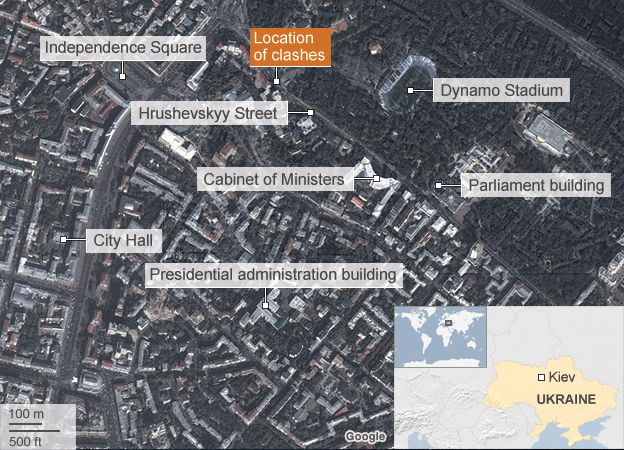Two protesters have been killed in clashes with police in the Ukrainian capital Kiev.
Prosecutors confirmed they had died from bullet wounds. They are the first fatalities since anti-government protests began in November.
Wednesday's clashes began after police moved in to dismantle a protest camp.
After talks with President Viktor Yanukovych, one opposition leader, Vitali Klitschko, threatened to lead protesters "on the attack".
"Today they [the police] are preparing to clear us out of the Maidan (Independence Square)," Mr Klitschko declared.
"We must do all we can to stop them clearing us out."
He said the president could end the stand-off by calling early elections but that "tomorrow, if the president does not respond... then we will go on the attack", to roars of approval from the crowd.
Meanwhile, the US embassy in Ukraine said it had revoked the visas of "several Ukrainians who were linked to the violence". It did not give names, but said it was "considering further action against those responsible for the current violence".
The clashes took place on the day that new anti-protest laws come into force. Parliament approved the laws last week, triggering renewed protests which spilled into violence on Sunday night.
Hundreds of people have been injured, though some of the violence has been blamed on a little-known far-right group, Right Sector.
Analysis
Although numerous details surrounding the protesters' deaths are still unclear - including whether it was indeed a police rifle that killed one activist - the simple fact that there have been losses of life will undoubtedly drive the anti-government movement to new, and possibly explosive, levels of outrage.
The ongoing fighting between demonstrators and riot police has been ferocious, but limited; hostilities have been restricted to a small corner of the capital near the government building, and the two sides observe many breaks in clashes.
But all this may be about to change. More activists are flooding into Kiev from the west, and crowds are massing at the site of the clashes. As the anger and the number of people mounts, the likelihood of a massive outbreak of violence, from either side, increases.
The tension is also rising in Kiev's Independence Square. Activists are forming self-defence groups and reinforcing the barricades. After PM Azarov announced that authorities could use force to restore order, protesters are preparing themselves for any possible development.
The anti-government movement started in protest at Mr Yanukovych's decision in late November to pull out of a landmark treaty with the EU, but has expanded to demand his resignation.
FireworksWednesday's violence began in a small area around Hrushevskyy Street, a road leading to government buildings and also close to the main protest encampment at Maidan (or Independence Square).
Shortly after 08:00 (06:00 GMT) - following a relatively peaceful night - police stormed the protesters' barricades on Hrushevskyy Street.
The police later fell back to their positions after fierce clashes with protesters, but by the afternoon had pushed on through the barricades.
Protesters again hurled petrol bombs and stones while riot police responded with stun grenades and rubber bullets, the BBC's Duncan Crawford reports.
“Start Quote
BBC reporterSeveral riot policemen came up to the body and started to prod it with their hands and feet”
Meanwhile, thousands of protesters have gathered in Independence Square.
There was a crush at one of the narrow entrances into the square when protesters trying to get in met protesters who were trying to get out to fight the police, our correspondent says.
At least two ambulances were seen carrying away the wounded.
Black smoke caused by the burning of tyres was billowing over Kiev, and video footage showed armoured vehicles moving into the area.
Officials confirmed the deaths of two people who were found with gunshot wounds earlier on Wednesday.
The general prosecutor said their bodies were found close to the scene of the clashes.
Key dates
21 November 2013: Ukraine announces it will not sign a deal aimed at strengthening ties with the EU
30 November: Riot police detain dozens of anti-government protesters in a violent crackdown in Kiev
17 December: Russia agrees to buy $15bn (£9.2bn, 11bn euros) of Ukrainian government bonds and slash the price of gas
22 January 2014: Two protesters die from bullet wounds during clashes with police in Kiev
One of them is thought to be Sergei Nigoyan, a 20-year-old ethnic Armenian who reportedly joined the protests in Kiev in early December.
Medics for the activists say at least one person had multiple wounds and claimed he had been killed by a police sniper.
A third activist was also reported to have died from injuries sustained after falling from the top of the Dynamo football stadium.
But a spokeswoman for Kiev's health department said the man had survived the fall and was being treated in the hospital.
'Systematic violation'Prime Minister Mykola Azarov denied that the police were responsible for the deaths, saying they were not carrying live ammunition.
They "remain on the consciousness and responsibility of the organisers and certain participants of mass disturbances", he said.
 President Viktor Yanukovych met
three opposition leaders to discuss the crisis
President Viktor Yanukovych met
three opposition leaders to discuss the crisis Many of the protesters have been wearing helmets and facemasks in defiance of the new laws that ban the wearing of such headgear at protests.
The laws also prescribe jail terms for anyone blockading public buildings and outlaw unauthorised tents in public areas.
European Union leaders have expressed shock at the deaths and called for on all sides to halt the violence.
"If there is a systematic violation of human rights, including shooting at peaceful demonstrators or serious attacks to the basic freedoms, then we have to rethink our relationship with Ukraine," said Jose Manuel Barroso, the president of the EU Commission.
The US also strongly condemned the escalating situation.
"Increased tensions in Ukraine are a direct consequence of the Ukrainian government's failure to engage in real dialogue and the passage of anti-democratic legislation," a US state department spokeswoman said.
Russia has accused the EU and US of "outside interference" in Ukrainian affairs.
"The extremist part of the opposition is crudely violating the country's constitution," Russia's Deputy Foreign Minister Grigory Karasin told Interfax news agency.
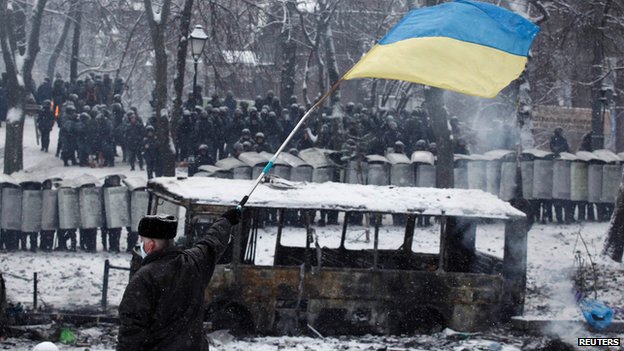 Police have retreated since
moving in on a camp in Hrushevskyy Street early on
Wednesday, but a tense stand-off remains
Police have retreated since
moving in on a camp in Hrushevskyy Street early on
Wednesday, but a tense stand-off remains  Firebombs were thrown by both
sides as the violence broke out
Firebombs were thrown by both
sides as the violence broke out 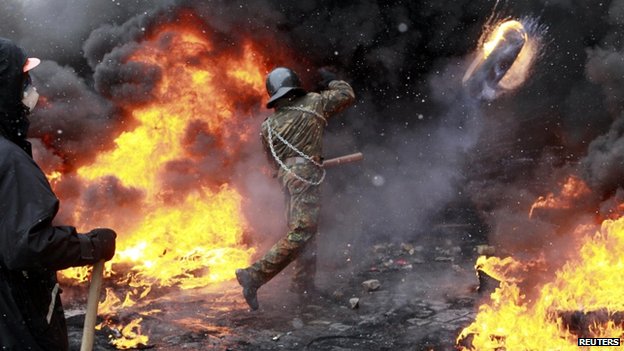 Demonstrators were setting tyres
on fire and throwing them at security forces
Demonstrators were setting tyres
on fire and throwing them at security forces 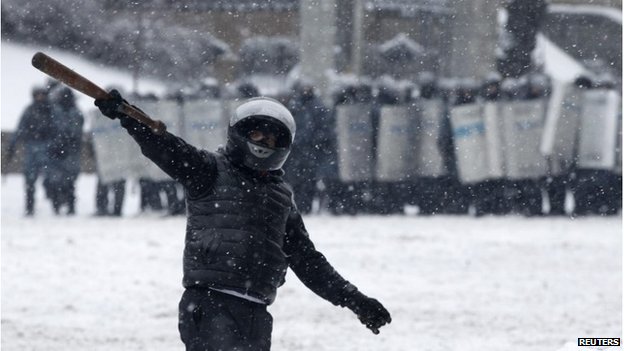 Many protesters were wearing
masks and helmets, breaking the new protest laws
Many protesters were wearing
masks and helmets, breaking the new protest laws
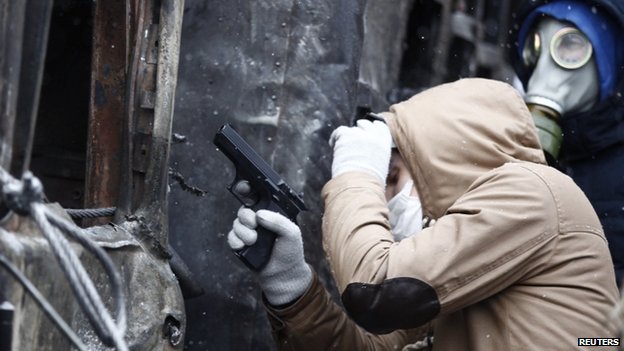 Some were seen brandishing
handguns
Some were seen brandishing
handguns 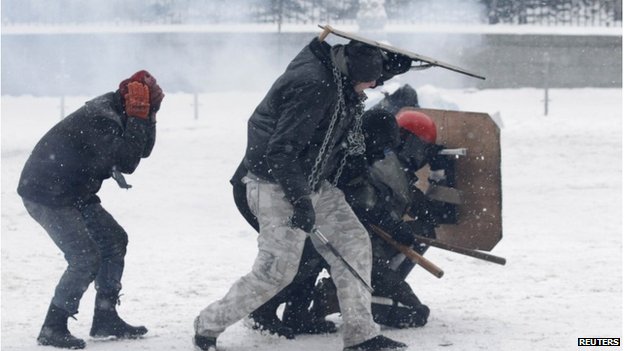 The clashes are taking place
amid heavy snowfall
The clashes are taking place
amid heavy snowfall 